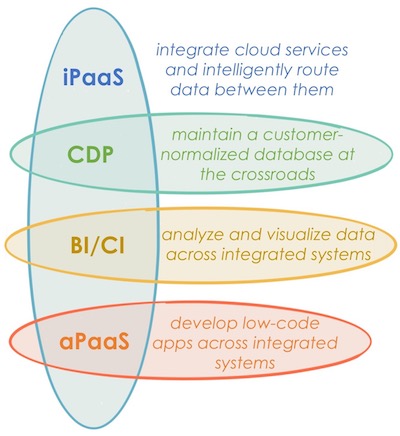Yesterday, Mulesoft announced it was being acquired by Salesforce for $6.5 billion. That’s a pretty hefty premium — a 21.6X multiple — given that the company had less than $300 million in revenue for 2017.
That’s a strategic bet. So what’s the strategy?
Although I’ve sworn off the game of making predictions, I do feel this validates one of the 5 big disruptions to marketing that I’ve been clamoring about for the past two years: the rise of microservices & APIs across marketing and other business services (that’s the 2018 update, here’s the original 2016 post).
Which is kind of a techy way of describing the explosion of marketing technology.
Essentially, we’re moving to a world of “infinite” software services running in the cloud that interact with each other in highly flexible configurations. I say “infinite” because digital business is always adding one more — n + 1 — cloud component into its operations. It’s the Inductive Theorem for the cloud.
Even if old services go away — and they do — new ones arrive to take their place. And the old ones don’t seem to go away as fast as the new ones arrive. Mary Meeker’s State of the Internet report last year revealed that the average enterprise uses over 1,000 different cloud services. It may sound anomalous at first, but this is not an anomaly. This is the new normal.
I’d be tempted to call this “cloud creep,” but that implies it’s a negative phenomenon. While it certainly has its challenges — such as data management — it also has benefits too: far greater agility than the monolithic IT systems of previous decades.
As the number of cloud services adopted by a company grows, the “size” of each service — the scope of what it does, its purpose — tends to shrink. We have more and more specialist services across the marketing technology landscape. Hence the name “microservices” — which used to be just exposed to developers, but increasingly play a role in the design of business workflow. (As a techy note: the serverless computing movement is going to accelerate both of these trends, further shrinking the size of services and multiplying the number of them out there.)
Why do companies keeping building and adopting more? Agility.
Moving away from monolithic systems, which can take months or years to change, to a loose affiliation of multiple cloud services that can now be dynamically added or reconfigured in a matter of days or weeks (or sometimes even minutes!) dramatically accelerates the clockspeed of digital business.
My opinion — and I should disclaim that as the VP platform ecosystem at HubSpot I am surely biased in my viewpoint and that this is also my personal opinion and not necessarily the company’s — is that this “cloud creep” has been frustrating for many of the major marketing cloud vendors. The early strategy that many of them pursued, attempting to consolidate everything into one mega-suite, has continually been foiled by an ever-expanding landscape of new, small, fast-moving, innovative SaaS ventures.
In fact, the rise of iPaaS (integration platform-as-a-service) vendors is arguably a reaction to the disconnect between consolidation strategies and fragmentation realities.
While Mulesoft is on the “heavier” end of the spectrum — their origin is as an enterprise service bus (ESB) solution meant to be wielded by IT pros — they’ve been steadily headed in the direction of democratizing their integration capabilities to support citizen integrators.
My definition of CITIZEN INTEGRATORS from my post on digital transformation: non-technical (or minimally-technical) professionals who use iPaaS and other workflow automation tools to create business processes on-the-fly, intelligently routing data and triggering activities across multiple teams.
This is the kind of data and workflow automation that marketing operations teams thrive on.
Integration solutions such as iPaaS have become very popular because that take the reality of the fragmentation of infinite cloud services and make it more manageable. Not seamless, but above the threshold of a minimally viable integration for pretty much any service you want to connect to it.
I look at Salesforce acquiring Mulesoft as an acknowledgement of that reality and a strategic decision to embrace it. And I generally think that’s a smart move.
However, as my friend David Raab pointed out, integration isn’t the same as unification.
While iPaaS solutions solve an important problem of dynamically connecting systems together and exchanging data between them, they’re generally neutral about the data flowing through their pipes.
They leave things like identity resolution and campaign decisioning to the systems attached as spokes to their hub.
An iPaaS is not a system of record. It’s a system of transport.
While that’s workable in a number of scenarios — especially if you’re comfortable with a more federated approach to data in your marketing stack — it’s not the only architecture available to marketing today.
Customer data platforms (CDPs) take the plumbing of iPaaS solutions and seek to be the intelligent repository of all the data that flows through their connections — maintaining a customer-normalized database at the crossroads.
I also see similarities in more modern business intelligence and customer intelligence solutions that layer greater insight engines on top of such a centralized data repository.
Salesforce will naturally benefit from Mulesoft integrations feeding into their CRM. But a CRM isn’t the same as a CDP. A DMP is slightly different too. It will be interesting to see how these related-but-not-the-same technologies compete and/or converge as they increasingly talk with each other.
Never a dull moment in the marketing technology space.
P.S. By the way, if you want to learn more about citizen integrators and CDPs, you’ve got to come to the MarTech conference, April 23-25 in San Jose.
One of our keynotes will be an in-depth discussion of this “citizen technologist” movement — citizen integrators, citizen developers, citizen data scientists — and what it means for marketing with the CEO of IFTTT, the CEO of Zapier, the CMO of Tableau, and myself. Have you thought about your team as citizen integrators? Even wilder, have you thought about your customers as citizen integrators?
David Raab will also be presenting a session on Navigating the CDP Landscape, to guide you through the dozens of vendors offering solutions under that label. And if you really want to dive into CDPs, he’ll be leading an optional 4-hour workshop on Using CDP to Make the Most of Your Customer Data.
And, of course, 40+ other sessions on the state-of-the-art at the intersection of marketing, technology, and management. It’s going to be an amazing 3 days — hope to see you there.






